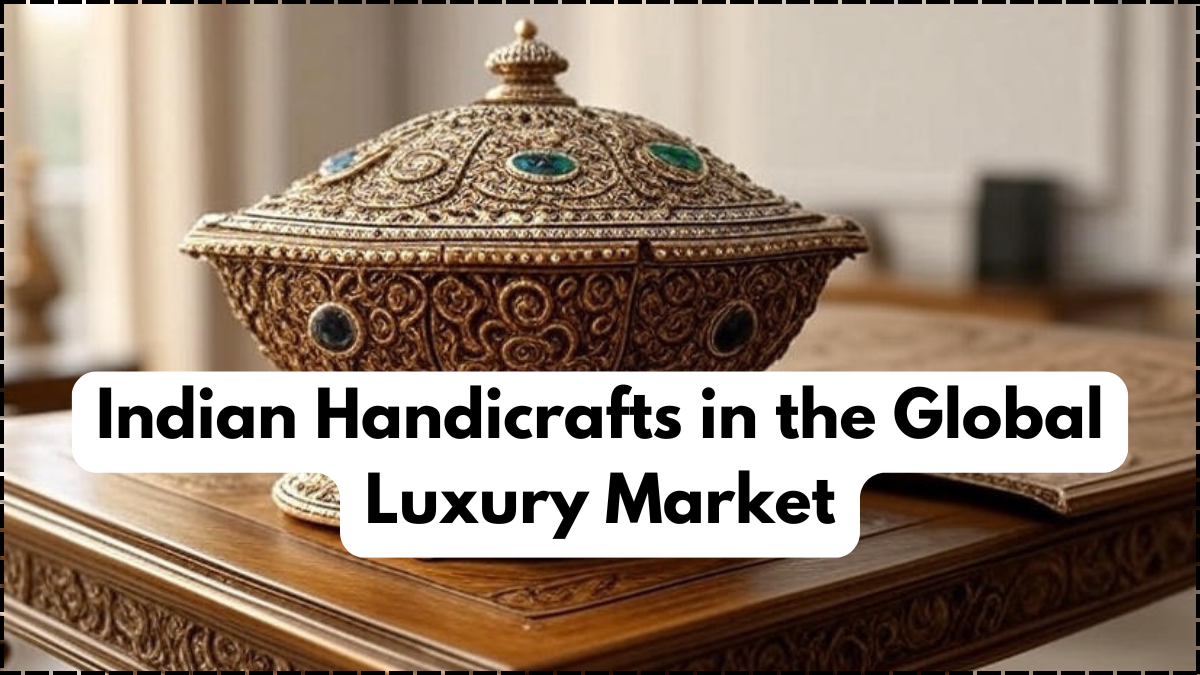For centuries, Indian handicrafts have been admired worldwide for their intricate designs, cultural depth, and traditional craftsmanship. From handwoven textiles to carved wood, pottery, and jewelry, these creations represent not only India’s rich history but also its global economic potential. Today, the global luxury industry is turning its attention toward authentic, handmade products that tell a story, and this has placed India in a strong position. With rising demand for authenticity and sustainable practices, artisan exports from India are becoming an important part of the international luxury market.

The Global Appeal of Indian Handicrafts
Modern consumers, especially in Western markets, are increasingly drawn to handmade, ethically sourced goods. Mass-produced items often lack the uniqueness that luxury buyers seek, making Indian handicrafts highly desirable. They represent a blend of tradition and modern style, which appeals to both collectors and young buyers. This shift has encouraged luxury brands to collaborate with Indian artisans, boosting artisan exports to Europe, North America, and the Middle East.
Key drivers of global demand include:
- Growing interest in sustainable fashion and décor
- Preference for handmade, limited-edition products
- Cultural fascination with Indian art and traditions
- Rising online platforms connecting artisans directly to buyers
Contribution of Artisan Exports to India’s Economy
The growth of artisan exports has had a significant economic impact. Millions of artisans across India rely on craft production for their livelihoods. By tapping into global markets, these communities are experiencing better incomes and recognition. Government initiatives, trade fairs, and e-commerce platforms are helping Indian handicrafts reach new international buyers.
A closer look at export data shows the increasing relevance of handicrafts:
| Year | Value of Artisan Exports (USD Billion) | Key Markets for Indian Handicrafts |
|---|---|---|
| 2018-2019 | 3.7 | USA, UK, UAE, Germany |
| 2019-2020 | 3.5 | USA, France, Australia |
| 2020-2021 | 3.2 (Pandemic impact) | Middle East, Europe |
| 2021-2022 | 4.0 | USA, Canada, Japan, Europe |
| 2022-2023 | 4.5 | Global luxury markets expanding |
This table demonstrates how artisan exports are steadily growing, despite challenges like the pandemic, making Indian handicrafts a strong force in luxury trade.
Challenges in Competing with the Luxury Market
While opportunities are growing, challenges remain. Many artisans lack direct access to international buyers and rely on middlemen, which reduces their profit margins. Intellectual property rights are also an issue, as counterfeit replicas often damage the reputation of authentic crafts. In addition, global competition requires consistency in quality and timely delivery, areas where support systems need to improve.
To make Indian handicrafts truly competitive in luxury markets, policies must focus on better infrastructure, design innovation, and fair trade practices. Enhancing digital literacy and promoting e-commerce platforms can also make artisan exports more competitive on the global stage.
The Way Forward for Indian Handicrafts
The future of Indian handicrafts in the global luxury market looks bright. With the rising trend of conscious consumerism, handmade products have become symbols of authenticity and sustainability. India’s diverse craft heritage, combined with growing international recognition, creates a unique opportunity for artisans. Governments, private companies, and NGOs must work together to create fairer systems and ensure artisans receive recognition and fair compensation.
By focusing on innovation, quality assurance, and cultural branding, artisan exports can achieve greater success worldwide. More importantly, this growth will also empower millions of rural artisans, helping preserve traditions while securing better livelihoods.
Conclusion
The global luxury market is evolving, and Indian handicrafts are at the heart of this transformation. As buyers increasingly choose authenticity over mass production, the demand for artisan exports will continue to rise. With stronger policies, technological support, and global promotion, Indian artisans can not only preserve their heritage but also thrive as major contributors to the international luxury market.
FAQs
Why are Indian handicrafts popular in global luxury markets?
They are admired for their authenticity, cultural depth, and handmade uniqueness, which luxury buyers value.
How do artisan exports benefit the Indian economy?
Artisan exports provide income for millions of craftsmen and help India strengthen its trade presence worldwide.
What challenges do Indian handicrafts face in global trade?
Key challenges include limited market access, counterfeit products, and the need for quality consistency.
What is the future of artisan exports from India?
With growing demand for sustainable and handmade products, artisan exports are expected to expand further into global luxury markets.
Click here to learn more